 |
 |
|
 |
|
 |
|  |
|  |
|
 |
|
 |
|  |
|  |
|
 |
Here is a zip containing files you may use to render the mandelbulb in
POV-Ray. It contains the following files, mbsdl_* for use with any
version of POV-Ray, and mb_* for use with a patched POV-Ray.
mbsdl_standalone.pov and mb_standalone.pov are minimal files with no
dependencies.
mbsdl.inc This is the include file used by all of the mbsdl_*
files below.
mbsdl_stage1.pov mb_stage1.pov Minimal files
mbsdl_basic.pov mb_basic.pov A mandelbulb isosurface colored by a
'bulb function
mbsdl_powers.pov mb_powers.pov Six mandelbulbs, powers 2-7
mbsdl_multi_p.pov mb_multi_p.pov Six composite power bulbs
mbsdl_pattern.pov mb_pattern.pov Use f_mandelbulb() as a pigment pattern
mbsdl_media.pov mb_media.pov Use f_mandelbulb() as a media density
mbsdl_renderall.sh mb_renderall.sh Bash scripts to render them all. (Linux)
There is also a long README.TXT, patches and replacement files to add
f_mandelbulb() internally, and a patch to extend the expiration of beta 34.
Post a reply to this message
Attachments:
Download 'f_mandelbulb.010.zip' (57 KB)
|
 |
|  |
|  |
|
 |
|
 |
|  |
|  |
|
 |
Here are small anti-aliased images of each of the scene files.
Post a reply to this message
Attachments:
Download 'mb_basic.png' (70 KB)
Download 'mb_media.png' (57 KB)
Download 'mb_multi_p.png' (50 KB)
Download 'mb_pattern.png' (52 KB)
Download 'mb_powers.png' (59 KB)
Download 'mb_stage1.png' (11 KB)
Download 'mb_standalone.png' (36 KB)
Preview of image 'mb_basic.png'
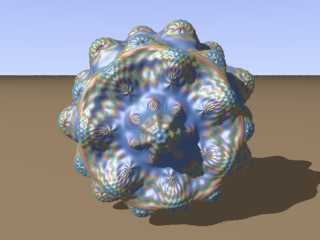
Preview of image 'mb_media.png'

Preview of image 'mb_multi_p.png'
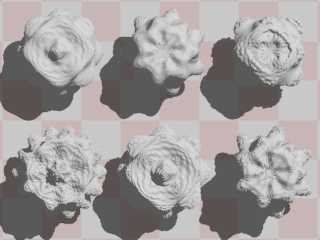
Preview of image 'mb_pattern.png'
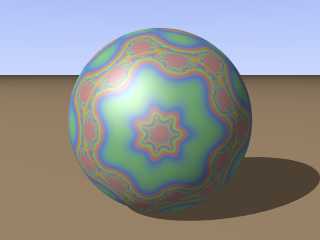
Preview of image 'mb_powers.png'
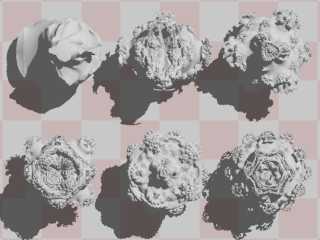
Preview of image 'mb_stage1.png'

Preview of image 'mb_standalone.png'
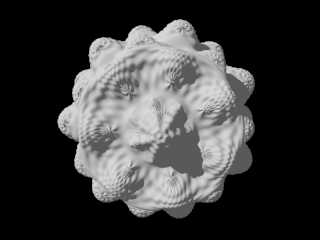
|
 |
|  |
|  |
|
 |
|
 |
|  |
|  |
|
 |
Here's the update. [I see the .binaries, so I should be OK.]
I incremented straight to 0.020 since the new function has one more
parameter than the old (making it incompatible with existing calls), a
phase parameter between p_phi and i.
I also put in a clunky way to switch between using the SDL and internal
function, if you compiled it into POV-Ray with the internal patch. Just
rename or remove the mbsdl.inc file and the sample scenes will switch to
using the internal function. I updated the README.TXT to try to explain
these and other mostly minor changes.
Also, I added another sample showing the four major variations. The
mb_variations.pov scene file is set to show the four power 8 variations,
but I also attached an image of the power two variants to highlight the
differences.
Happy 'Bulbing!
~David
Post a reply to this message
Attachments:
Download 'f_mandelbulb.020.zip' (50 KB)
Download 'mb_variations.png' (35 KB)
Download 'mb2_variations.png' (34 KB)
Preview of image 'mb_variations.png'
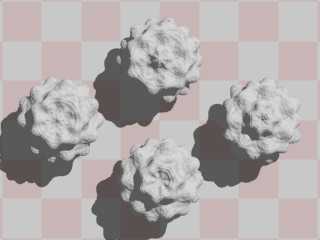
Preview of image 'mb2_variations.png'

|
 |
|  |
|  |
|
 |
|
 |
|  |
|  |
|
 |
This looks an awful lot like a 3D version of the tricorn to me.
http://en.wikipedia.org/wiki/Tricorn_%28mathematics%29
It's made with the new function using a phase of 0, p_r=2, p_theta=-2,
p_phi=2 at ten iterations. (Note the negative p_theta.)
On another note, Paolo Bonzini recently published a paper describing how
to express the mandelbulb function variations as a quaternion function
mapping. I generalized his expression to work with any scalar power,
and besides being more flexible, it looks like it will be more
computationally efficient than the non-integral exponent versions of the
White, Nylander, et. al., formulae (the ones currently in use).
This quaternion version requires only 1 atan2, 1 cos, 1 sin, 2 sqrt, 1
fractional pow(), and 3 scalar divisions per iteration (along with a
bunch of fast multiplies and adds). Unfortunately, the expression
becomes extremely cumbersome when attempting to shoehorn it into a
single SDL function, so no working code yet.
I also plan to flirt with insanity by taking a crack at reworking it for
full quaternion power exponents.
~David
Post a reply to this message
Attachments:
Download 'mb_iso_tricorn.png' (130 KB)
Preview of image 'mb_iso_tricorn.png'
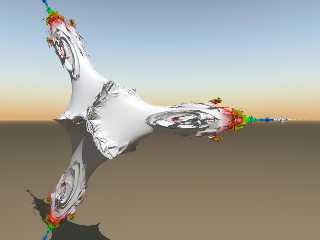
|
 |
|  |
|  |
|
 |
|
 |
|  |
|  |
|
 |
I previosly wrote:
> I also plan to flirt with insanity by taking a crack at reworking it for
> full quaternion power exponents.
Well, something cracked, all right. Since I had to recompile anyway, I
went ahead and coded a full quaternion power version. Once I worked out
the math (or more accurately, it worked me out), the resulting algorithm
isn't that much more computationally intensive than the old White and
Naylander formulas, and may even be a touch faster. (It would still be
too much to code in SDL unless I can learn how to build functions from
macros, or write an external script to make the SDL function.)
However, although it returns a reasonable straight power-two mandelbulb,
the current code doesn't seem to be doing higher powers quite right.
Regardless, what varying the imaginary parts of the quaternion power
does is indescribable.
There are much weirder 'bulbs than the one attached, but this (2,0,1,0)
quaternion power beast seemed appropriate for the new year.
Wishing ya'll the best!
~David Wagner
Post a reply to this message
Attachments:
Download 'mbq2010_beast_512.png' (136 KB)
Preview of image 'mbq2010_beast_512.png'

|
 |
|  |
|  |
|
 |
|
 |
|  |
|  |
|
 |
Earlier, I blathered:
> However, although it returns a reasonable straight power-two mandelbulb,
> the current code doesn't seem to be doing higher powers quite right.
> Regardless, what varying the imaginary parts of the quaternion power
> does is indescribable.
>
> There are much weirder 'bulbs than the one attached, but this (2,0,1,0)
> quaternion power beast seemed appropriate for the new year.
I found and corrected one error that only applied to using a power with
an imaginary part. I attached the 2,0,1,0 mandelquat after rendering it
with the updated code.
For pure real power mandelbulbs, I'm still only getting the expected
results for power two, and still don't know why.
~David
Post a reply to this message
Attachments:
Download 'mbq2010_beast_640.png' (199 KB)
Preview of image 'mbq2010_beast_640.png'

|
 |
|  |
|  |
|
 |
From: waggy
Subject: Mandelquat Mapping (WAS: Happy 2,0,1,0 Quaternion-power 'Bulb!)
Date: 3 Jan 2010 23:40:45
Message: <4b41714d$1@news.povray.org>
|
|
 |
|  |
|  |
|
 |
waggy babbled on:
> For pure real power mandelbulbs, I'm still only getting the expected
> results for power two, and still don't know why.
Bonzini updated his paper today, and my pure real power results are
consistent with his. The formulas needed to reproduce arbitrary real
higher-power mandelbulbs using quaternions are quite different than
originally described (except for power two, after trig reduction), and
seem to involve even more trig functions than the classic formulation.
http://github.com/bonzini/mbulb/raw/master/mbulb.pdf
There still may or may not be errors in how my code handles the
imaginary part of quaternion powers. I think I need to take a step back
and figure out what it's supposed to do rather than continue to muck
about with variations.
If there's interest, I'll post what I have so far. Otherwise, I'll hang
onto it until I can describe what it does.
~David
Post a reply to this message
|
 |
|  |
|  |
|
 |
|
 |
|  |
|  |
|
 |
waggy <hon### [at] handbasket org> wrote:
> I previosly wrote:
> > I also plan to flirt with insanity by taking a crack at reworking it for
> > full quaternion power exponents.
>
> Well, something cracked, all right. Since I had to recompile anyway, I
> went ahead and coded a full quaternion power version. Once I worked out
> the math (or more accurately, it worked me out), the resulting algorithm
> isn't that much more computationally intensive than the old White and
> Naylander formulas, and may even be a touch faster. (It would still be
> too much to code in SDL unless I can learn how to build functions from
> macros, or write an external script to make the SDL function.)
....
David,
If you would like to see how hyou can build functions with macros,
then below is a macro that produces a function that is similar to
your recursive (non-quaternion) Mandelbrot function.
// ===== 1 ======= 2 ======= 3 ======= 4 ======= 5 ======= 6 ======= 7
#macro MandelBulbFunction(R_Pwr, R_BO, Ph_Pwr, Ph_Phase, Th_Pwr, Max_Iter)
#local ln_R_BO = ln(R_BO);
#local ln_R_Pwr = ln(R_Pwr);
#local J = Max_Iter - 1;
#local MB_Fns = array[Max_Iter][2]
#local I = Max_Iter;
#while (I > 0)
#local I = I - 1;
#local MB_Fns[I][1] =
function(x, y, z, _r, _rp, _ph, _th) {
#if (I = J)
0
#else
select(
_r - R_BO,
MB_Fns[I+1][0](
x,
y,
z,
x + _rp*cos(_ph)*cos(_th),
y + _rp*sin(_ph),
z + _rp*cos(_ph)*sin(_th)
),
1/(I - ln(ln(_r)/ln_R_BO)/ln_R_Pwr)
)
#end // if
}
#local MB_Fns[I][0] =
function(x, y, z, _ix, _iy, _iz) {
MB_Fns[I][1](
x,
y,
z,
f_r(_ix, _iy, _iz),
pow(f_r(_ix, _iy, _iz), R_Pwr),
Ph_Pwr*(f_ph(_ix, _iy, _iz) + Ph_Phase),
Th_Pwr*f_th(_ix, _iy, _iz)
)
}
#end // while
function { MB_Fns[0][0](x, y, z, x, y, z) }
#end // macro MandelBulbFunction
// It can be used like this:
#declare MandelBulbFn = MandelBulbFunction(8, 3, 8, pi/2, 8, 5)
// ===== 1 ======= 2 ======= 3 ======= 4 ======= 5 ======= 6 ======= 7
--
Tor Olav
http://subcube.com org> wrote:
> I previosly wrote:
> > I also plan to flirt with insanity by taking a crack at reworking it for
> > full quaternion power exponents.
>
> Well, something cracked, all right. Since I had to recompile anyway, I
> went ahead and coded a full quaternion power version. Once I worked out
> the math (or more accurately, it worked me out), the resulting algorithm
> isn't that much more computationally intensive than the old White and
> Naylander formulas, and may even be a touch faster. (It would still be
> too much to code in SDL unless I can learn how to build functions from
> macros, or write an external script to make the SDL function.)
....
David,
If you would like to see how hyou can build functions with macros,
then below is a macro that produces a function that is similar to
your recursive (non-quaternion) Mandelbrot function.
// ===== 1 ======= 2 ======= 3 ======= 4 ======= 5 ======= 6 ======= 7
#macro MandelBulbFunction(R_Pwr, R_BO, Ph_Pwr, Ph_Phase, Th_Pwr, Max_Iter)
#local ln_R_BO = ln(R_BO);
#local ln_R_Pwr = ln(R_Pwr);
#local J = Max_Iter - 1;
#local MB_Fns = array[Max_Iter][2]
#local I = Max_Iter;
#while (I > 0)
#local I = I - 1;
#local MB_Fns[I][1] =
function(x, y, z, _r, _rp, _ph, _th) {
#if (I = J)
0
#else
select(
_r - R_BO,
MB_Fns[I+1][0](
x,
y,
z,
x + _rp*cos(_ph)*cos(_th),
y + _rp*sin(_ph),
z + _rp*cos(_ph)*sin(_th)
),
1/(I - ln(ln(_r)/ln_R_BO)/ln_R_Pwr)
)
#end // if
}
#local MB_Fns[I][0] =
function(x, y, z, _ix, _iy, _iz) {
MB_Fns[I][1](
x,
y,
z,
f_r(_ix, _iy, _iz),
pow(f_r(_ix, _iy, _iz), R_Pwr),
Ph_Pwr*(f_ph(_ix, _iy, _iz) + Ph_Phase),
Th_Pwr*f_th(_ix, _iy, _iz)
)
}
#end // while
function { MB_Fns[0][0](x, y, z, x, y, z) }
#end // macro MandelBulbFunction
// It can be used like this:
#declare MandelBulbFn = MandelBulbFunction(8, 3, 8, pi/2, 8, 5)
// ===== 1 ======= 2 ======= 3 ======= 4 ======= 5 ======= 6 ======= 7
--
Tor Olav
http://subcube.com
Post a reply to this message
|
 |
|  |
|  |
|
 |
|
 |
|  |
|  |
|
 |
Tor Olav Kristensen wrote:
> If you would like to see how hyou can build functions with macros,
> then below is a macro that produces a function that is similar to
> your recursive (non-quaternion) Mandelbrot function.
Thank you very much!
All things considered, unless there is a big performance hit for some
reason, I'd prefer to use this method to build the user-defined function
at parse time. The recursive formulation always struck me as an odd way
to iterate, and povray crashing when the function is defined at the
"wrong" time is reason enough not to stick with it.
Besides, if the quaternion road leads somewhere fruitful, trying to
combine all the intermediate expressions by hand would be a nightmare.
With Great Appreciation,
~David Wagner
Post a reply to this message
|
 |
|  |
|  |
|
 |
|
 |
|  |
|  |
|
 |
"Tor Olav Kristensen" <tor### [at] TOBEREMOVEDgmail com> wrote:
> [SNIP]
> // It can be used like this:
> #declare MandelBulbFn = MandelBulbFunction(8, 3, 8, pi/2, 8, 5)
>
could you please make a pov file with that for all the newbies to learn from? com> wrote:
> [SNIP]
> // It can be used like this:
> #declare MandelBulbFn = MandelBulbFunction(8, 3, 8, pi/2, 8, 5)
>
could you please make a pov file with that for all the newbies to learn from?
Post a reply to this message
|
 |
|  |
|  |
|
 |
|
 |
|  |
|
 |




![]()